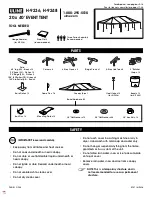
7
Food in Tents
Mop up spills promptly with water. Many foods, particularly acidic ones
like fruit or juices, can weaken synthetic fabrics over time. In any case it is
best to eat and store food away from a tent to avoid attracting animals.
Cleaning
Clean the tent by hand while it is set up, using a sponge, a mild non-
detergent soap, and warm water. Rinse thoroughly. Do not dry clean,
machine wash, or machine dry. Stubborn stains like tar can be left in place
and dusted with talcum powder to prevent transfer to other areas of the
tent in storage. After cleaning, a spray-on water repellent designed for
synthetic fabrics may be applied to the fl ysheet if surface water repellency
is weakening. (This is apparent when water droplets no longer bead up
on the fabric.)
If the poles are exposed to salt or salt water, rinse them in fresh water and
allow them to dry before storing. (While aluminum does not rust, it can
become brittle through unseen corrosion over time.)
If the poles are exposed to salt or salt water, rinse them in fresh water and
allow them to dry before storing. (While aluminum does not rust, it can
become brittle through unseen corrosion over time.)
Lubricating the Poles
Occasionally apply a light coating of a silicone-based lubricant like 303
TM
Protectant to the tent pole connections. If the poles are used extensively
in marine environments, treat them more frequently.
Storing your Tent
Dry the tent and poles completely before storage to avoid mildew or
hidden pole corrosion. Store in a cool, dry place out of direct light.
Mildewed tents can be cleaned as described above, but there is no way
to remove the dark stains without damaging the fabric. Mildew will
probably take some time to affect the waterproof coatings, so the tent
should still be usable.
Tarn 2 eng.indd 7
Tarn 2 eng.indd 7
3/4/05 3:48:55 PM
3/4/05 3:48:55 PM


























